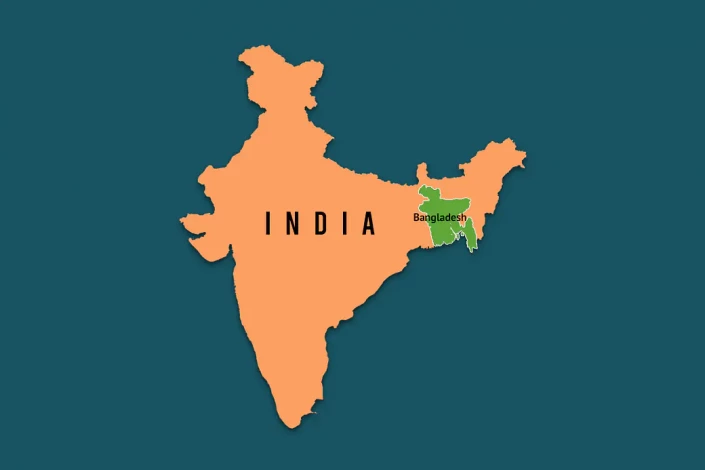
Bangladesh's bilateral trade with neighboring India is
increasing. As Bangladesh's import from India is increasing, Bangladesh's
export to the country is also increasing. However, considering the
import-export statistics, Bangladesh's trade deficit with India is now higher
than any time in the past.
In the last 10 years, the export of Bangladeshi products to
India has increased almost 4 times. In 2011-12 fiscal year, Bangladesh exported
goods worth 498.4 million dollars to India, which increased to 199 million
dollars in the last fiscal year 2021-22.
Similarly, in the fiscal year 2011-12, Bangladesh imported
goods worth 4.74 billion dollars from India. In the fiscal year 2021-22, it increased
to 1 thousand 619 dollars. As such, Bangladesh is now facing a deficit of 1,420
billion dollars in bilateral trade. If calculated at the rate of 95 taka per
dollar, the deficit in Bangladeshi currency stands at 1 lakh 35 thousand crore
taka. That is, Bangladesh imports more than eight times of its exports.
Data taken from the Bangladesh Bank, Export Promotion Bureau
(EPB) and the Indian High Commission in Dhaka have provided such information on
the import and export of the two countries.
Bangladesh's main exports to India are ready-made garments,
jute and jute products, leather products, plastic products, fish, soft drinks,
copper, edible oil etc. And the main products imported by Bangladesh from India
include rice, raw cotton, onions, automobiles, boilers, electronic products,
iron, machinery, milk and dairy products etc.
Bangladesh Prime Minister Sheikh Hasina went to Delhi last
Monday on a four-day state visit. The next day, Tuesday, he held a bilateral
meeting with Indian Prime Minister Narendra Modi. It mentioned among other
things the signing of the Bangladesh-India Comprehensive Economic Partnership
Agreement (CEPA).
Bangladesh Prime Minister Sheikh Hasina and Indian Prime Minister Narendra Modi announced the signing of SEPA at a joint press conference held in New Delhi after the bilateral meeting. At that time, Narendra Modi said, 'We are interested in increasing trade between the two countries. For that, I will start the process of signing SEPA.
Trade picture of both
countries
In 2011, India granted duty-free facilities to Bangladesh on
all goods except arms and drugs. Since then, the export of Bangladeshi products
to the country has been increasing. This tariff concession came into effect
when the then Prime Minister of India, Manmohan Singh, arrived in Bangladesh on
a state visit.
According to EPB data, Bangladesh exported goods worth USD
870 million to India in the fiscal year 2017-18. Since then the export revenue
has been above hundred million dollars every time. However, amid the Covid-19
pandemic, India exported $199 million worth of goods in the fiscal year
2021-22.
On the other hand, imports from India are increasing
massively. According to Bangladesh Bank's data analysis, in the fiscal year
2017-18, goods worth 8.62 billion dollars were imported from the country. In
the last fiscal year 2021-22, though there is a slight decrease in the middle,
the import has almost doubled, that is to 1 thousand 616 million dollars.
When asked, acting president of Bangladesh Garment
Manufacturers and Exporters Association (BGMEA) Shahidullah Azim told that
India is a big market for Bangladesh for bilateral trade. Bringing goods from
the country takes less time and cost, while sending goods to the country also
offers the same benefits. SEPA or Free Trade Agreement (FTA) will increase
trade between the two countries. It will benefit the people of both countries.
Shahidullah Azim thinks that infrastructure development of
land ports is necessary for the growth of trade.
Will the trade gap
decrease?
Bilateral trade has always been in favor of India. In the
last financial year, it suddenly became much bigger. Among these, Bangladesh's
multi-faceted challenges after transitioning from a LDC (LDC) has been
discussed anew. Bangladesh has proposed CEPA to India to deal with these
challenges.
In a report titled 'Interconnection for Prosperity:
Challenges and Opportunities of Integrated Transport System in Eastern South
Asia' published by the World Bank last year, it is said that 10 percent of
Bangladesh's total trade is with India, while India's trade with Bangladesh is
only 1 percent.
However, in case of FTA, Bangladesh's exports to India will
increase by 182 percent, while India's exports to Bangladesh will increase by
126 percent. And if uninterrupted transportation system is introduced,
Bangladesh's exports to India will increase by 297 percent and India's exports
to Bangladesh by 172 percent.
Salim Raihan, Executive Director of South Asian Network on
Economic Modeling (SANEM) told Prothom Alo, that more imports from India is not
a bad thing. And the trade gap cannot be reduced by increasing exports. CEPA
will be beneficial. This will not only increase the export of Bangladesh to
India, but also increase the import of Bangladesh from India. India will get
more tax benefit from it, it must also be kept in mind.
Salim Raihan said more attention can be paid to Indian
investment. It will create employment and help in growth. Bangladesh has
created a separate economic zone for the country to attract Indian investment.
But the success rate is very low.
Indian industrialist Gautam Adani, who is known as the third
richest man in the world, had a meeting with Bangladeshi Prime Minister Sheikh
Hasina, who is visiting Delhi, Salim Raihan believes that it is significant in
terms of investment attraction.
|Source:
Online/SZK
Comment Now